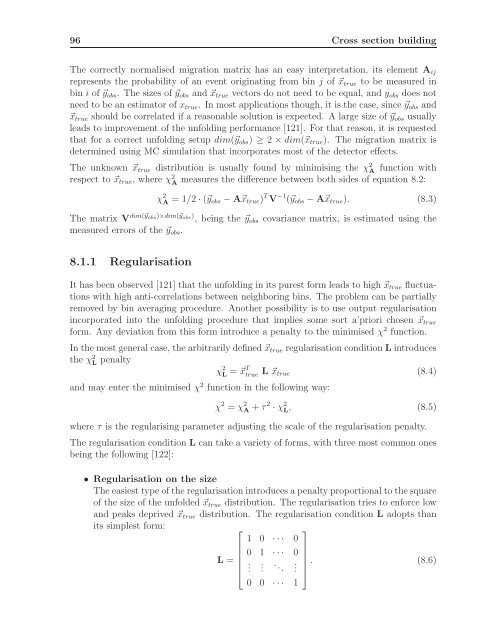10 - H1 - Desy
10 - H1 - Desy
10 - H1 - Desy
Create successful ePaper yourself
Turn your PDF publications into a flip-book with our unique Google optimized e-Paper software.
96 Cross section building<br />
The correctly normalised migration matrix has an easy interpretation, its element A ij<br />
represents the probability of an event originating from bin j of ⃗x true to be measured in<br />
bin i of ⃗y obs . The sizes of ⃗y obs and ⃗x true vectors do not need to be equal, and y obs does not<br />
need to be an estimator of x true . In most applications though, it is the case, since ⃗y obs and<br />
⃗x true should be correlated if a reasonable solution is expected. A large size of ⃗y obs usually<br />
leads to improvement of the unfolding performance [121]. For that reason, it is requested<br />
that for a correct unfolding setup dim(⃗y obs ) ≥ 2 × dim(⃗x true ). The migration matrix is<br />
determined using MC simulation that incorporates most of the detector effects.<br />
The unknown ⃗x true distribution is usually found by minimising the χ 2 A function with<br />
respect to ⃗x true , where χ 2 A measures the difference between both sides of equation 8.2:<br />
χ 2 A = 1/2 · (⃗y obs − A⃗x true ) T V −1 (⃗y obs − A⃗x true ). (8.3)<br />
The matrix V dim(⃗y obs)×dim(⃗y obs ) , being the ⃗y obs covariance matrix, is estimated using the<br />
measured errors of the ⃗y obs .<br />
8.1.1 Regularisation<br />
It has been observed [121] that the unfolding in its purest form leads to high ⃗x true fluctuations<br />
with high anti-correlations between neighboring bins. The problem can be partially<br />
removed by bin averaging procedure. Another possibility is to use output regularisation<br />
incorporated into the unfolding procedure that implies some sort a’priori chosen ⃗x true<br />
form. Any deviation from this form introduce a penalty to the minimised χ 2 function.<br />
In the most general case, the arbitrarily defined ⃗x true regularisation condition L introduces<br />
the χ 2 L penalty χ 2 L = ⃗xT true L ⃗x true (8.4)<br />
and may enter the minimised χ 2 function in the following way:<br />
χ 2 = χ 2 A + τ2 · χ 2 L , (8.5)<br />
where τ is the regularising parameter adjusting the scale of the regularisation penalty.<br />
The regularisation condition L can take a variety of forms, with three most common ones<br />
being the following [122]:<br />
• Regularisation on the size<br />
The easiest type of the regularisation introduces a penalty proportional to the square<br />
of the size of the unfolded ⃗x true distribution. The regularisation tries to enforce low<br />
and peaks deprived ⃗x true distribution. The regularisation condition L adopts than<br />
its simplest form:<br />
⎡ ⎤<br />
1 0 · · · 0<br />
0 1 · · · 0<br />
L =<br />
⎢ .<br />
⎣ . . .. ⎥ . ⎦ . (8.6)<br />
0 0 · · · 1
















